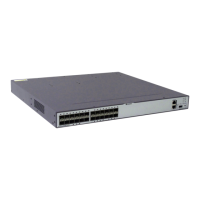4. Run:
quit
The system view is displayed.
l Enable static IPv4 BFD on an interface.
1. Run:
interface interface-type interface-number
The view of the specified interface is displayed.
2. Run:
isis bfd static
Static IPv4 BFD is enabled on the specified interface.
NOTE
To enable static IPv4 BFD on an RPR interface, use the isis bfd static and isis fast-sense
rpr commands or use only the isis fast-sense command.
The isis fast-sense command integrates the functions of the isis bfd static and isis fast-sense
rpr commands. Therefore, you can either configure the isis fast-sense command or configure
both the isis bfd static and isis fast-sense rpr commands.
----End
Checking the Configuration
Information about a BFD session can be viewed only after parameters of the BFD session are
set and the BFD session is established.
Run the display isis interface verbose command. The command output shows that the status
of static BFD for IS-IS process 1 is Yes.
6.10 Configuring Dynamic IPv4 BFD for IS-IS
Dynamic IPv4 BFD for IS-IS can accelerate IS-IS route convergence.
Context
Connection status between an IS-IS device and its neighbors can be monitored by exchanging
Hello packets at intervals. The minimum allowable sending interval is 3s, and a neighbor is
declared Down after at least three intervals during which no response Hello packet is received
from the neighbor. IS-IS takes more than one second to detect that a neighbor becomes Down,
resulting in loss of a large amount of high-speed data.
To solve this problem, BFD must be configured for IS-IS. IPv4 BFD provides millisecond-level
fault detection. After detecting a link or node failure, BDF will notify IS-IS of the failure,
accelerating the IS-IS route convergence speed.
Dynamic IPv4 BFD for IS-IS implements dynamic setup of BFD sessions. When a new IS-IS
neighbor relationship is set up, BFD is notified of the neighbor parameters and the detection
parameters (including source and destination IP addresses). Then a BFD session will be
established based on the received neighbor parameters. Dynamic BFD is more flexible than
static BFD.
S6700 Series Ethernet Switches
Configuration Guide - IP Routing 6 IS-IS Configuration
Issue 01 (2012-03-15) Huawei Proprietary and Confidential
Copyright © Huawei Technologies Co., Ltd.
281

